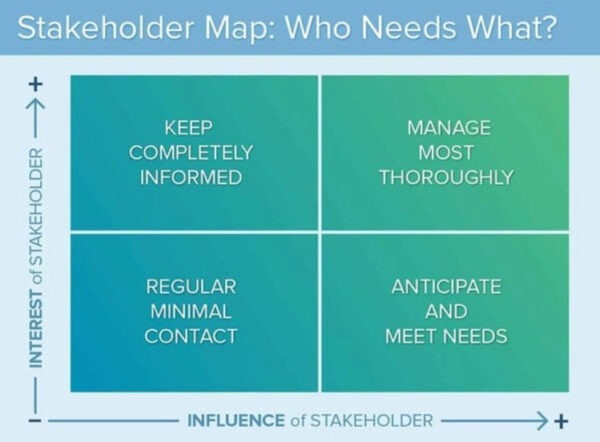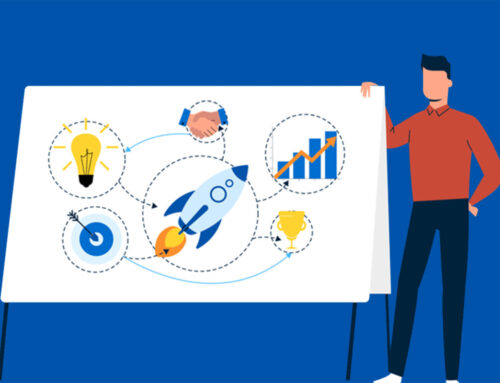Guide to Stakeholder Engagement
In this guide to stakeholder engagement, we provide an understanding of its purpose and benefits to implementing practical strategies for meaningful collaboration.
Stakeholder engagement is critical to project success, ensuring that everyone with an interest in, or influence over a project is aligned and actively participating in the process. Whether you’re managing a community initiative, developing a new product, or delivering a strategic business plan, engaging stakeholders effectively can lead to better outcomes, smoother workflows, and stronger relationships.
What is Stakeholder Engagement?
Stakeholder engagement is the process of interacting with individuals or groups who are affected by or can influence your project or organisation. These stakeholders can range from internal team members and investors to external parties like clients, suppliers, regulators, or the wider community.
The goal is to involve these stakeholders meaningfully, understand their perspectives, and incorporate their insights where relevant. Effective engagement involves ongoing dialogue, collaboration, and a structured approach to ensure everyone’s interests are acknowledged and considered.
Why is Stakeholder Engagement Important?
Stakeholder engagement is essential for creating successful outcomes and building a foundation of trust and cooperation. Here’s why it matters:
Aligning Expectations
Engaging stakeholders ensures that everyone is aligned on the project’s goals, reducing misunderstandings and miscommunication.
Addressing Concerns Proactively
Early and ongoing engagement helps identify potential challenges before they escalate into significant issues.
Enhancing Collaboration
When stakeholders feel involved, they’re more likely to contribute valuable insights, ideas, and resources.
Strengthening Relationships
A structured approach to engagement helps build long-term relationships that can benefit future projects and initiatives.
Ensuring Long-Term Support
Satisfied stakeholders are more likely to support your organisation, recommend your services, or invest in your future plans.
Benefits of Stakeholder Engagement
Improved Communication
Clear, consistent communication ensures that stakeholders remain informed and connected throughout the project. It reduces confusion and creates an open environment where feedback and ideas are easily shared.
Increased Buy-In
When stakeholders are actively involved, they feel a sense of ownership in the project’s success. This leads to greater commitment and a willingness to support decisions, even in challenging situations.
Reduced Risks
Understanding stakeholder concerns and addressing them early helps mitigate risks. It allows you to foresee and avoid potential obstacles that could derail the project.
Improved Performance
Collaboration with stakeholders can lead to better decision-making, innovative solutions, and more effective execution. The insights and expertise of stakeholders contribute to improved outcomes and overall success.
Inside the Engagement Process
1. Identify Stakeholders
Begin by identifying all individuals and groups who may impact or be impacted by your project. This includes internal stakeholders like employees or leadership teams, as well as external ones such as customers, investors, suppliers, or regulatory bodies.
2. Prioritise Stakeholders
Not all stakeholders will have the same level of influence or interest in your project. Conduct a stakeholder mapping exercise to classify them into categories such as:
- High influence, high interest.
- High influence, low interest.
- Low influence, high interest.
- Low influence, low interest.
This helps you focus your efforts on those stakeholders whose engagement will have the most significant impact.

The above stakeholder mapping exercise asks you to plot leaders on a two-by-two grid. One axis is labelled power and the other is interest.
On the power axis, you rate each stakeholder on their ability to influence the project. On the interest axis, you rate each stakeholder on their level of interest in the project. This will give you a clear picture of which stakeholders are the most important to engage with and how best to do so.
3. Assess Stakeholder Needs and Interests
Once you’ve identified and prioritised stakeholders, take the time to understand what matters most to each group. This can involve reviewing historical data, analysing communication patterns, or directly seeking input through questionnaires or informal discussions.
4. Define Stakeholder Motives
Understanding why stakeholders care about your project is crucial. Use tools like interviews, surveys, and focus groups to uncover their motivations, concerns, and aspirations. This information helps tailor your engagement approach to meet their expectations effectively.
5. Develop an Engagement Plan
An engagement plan outlines how and when you will communicate with stakeholders. Include strategies such as:
Frequent Communication
Regular updates through emails, meetings, newsletters, or project dashboards.
Consultation
Seeking input on critical decisions to make stakeholders feel valued and involved.
Collaboration
Actively involving stakeholders in parts of the project where their expertise or buy-in is crucial.
Tips for Stakeholder Engagement
Define the Purpose of the Project
Ensure that all stakeholders clearly understand the project’s objectives and how it aligns with their interests. Clear goals help create a sense of shared purpose and focus.
Define Roles and Resposibilities
Clarify the roles and responsibilities of everyone involved, including stakeholders. This prevents confusion, reduces duplication of effort, and ensures accountability.
Communicate Regularly
Establish consistent communication channels and schedules. Regular updates help stakeholders stay informed about progress, challenges, and changes. This keeps everyone aligned and engaged.
Be Transparent
Honesty and openness are essential. Share both successes and challenges, ensuring stakeholders have a realistic understanding of the project’s status. Transparency builds credibility and trust.
Seek Feedback
Encourage stakeholders to provide feedback throughout the project. Use surveys, suggestion boxes, or informal discussions to gather insights. Acting on their feedback demonstrates that their opinions are valued.
Choose the Right Software
The right tools can streamline collaboration. Platforms such as Basecamp, Asana, Google Drive, or Trello can help organise tasks, share updates, and track progress in real-time, making engagement more efficient.
Be Flexible
Recognise that projects often evolve. Be prepared to adjust your engagement strategies, timelines, or priorities based on stakeholder input or changing circumstances. Flexibility ensures that everyone remains aligned, even as challenges arise.
Conclusion
Stakeholder engagement is not a one-size-fits-all approach. It requires thoughtful planning, clear communication, and an ongoing commitment to understanding and addressing stakeholder needs. By creating meaningful connections, aligning expectations, and involving stakeholders throughout the process, you can achieve better results and long-lasting success.
At Minutiae Media, we specialise in helping organisations design and execute effective stakeholder engagement strategies. From identifying key players to crafting tailored communication plans, we’ll ensure your projects are set up for success.
Call Minutiae Media on 0203 712 6266 to discuss how we can support your stakeholder engagement efforts and drive impactful results for your organisation.
Guide to Stakeholder Engagement
In this guide to stakeholder engagement, we provide an understanding of its purpose and benefits to implementing practical strategies for meaningful collaboration.
Stakeholder engagement is critical to project success, ensuring that everyone with an interest in, or influence over a project is aligned and actively participating in the process. Whether you’re managing a community initiative, developing a new product, or delivering a strategic business plan, engaging stakeholders effectively can lead to better outcomes, smoother workflows, and stronger relationships.
What is Stakeholder Engagement?
Stakeholder engagement is the process of interacting with individuals or groups who are affected by or can influence your project or organisation. These stakeholders can range from internal team members and investors to external parties like clients, suppliers, regulators, or the wider community.
The goal is to involve these stakeholders meaningfully, understand their perspectives, and incorporate their insights where relevant. Effective engagement involves ongoing dialogue, collaboration, and a structured approach to ensure everyone’s interests are acknowledged and considered.
Why is Stakeholder Engagement Important?
Stakeholder engagement is essential for creating successful outcomes and building a foundation of trust and cooperation. Here’s why it matters:
Aligning Expectations
Engaging stakeholders ensures that everyone is aligned on the project’s goals, reducing misunderstandings and miscommunication.
Addressing Concerns Proactively
Early and ongoing engagement helps identify potential challenges before they escalate into significant issues.
Enhancing Collaboration
When stakeholders feel involved, they’re more likely to contribute valuable insights, ideas, and resources.
Strengthening Relationships
A structured approach to engagement helps build long-term relationships that can benefit future projects and initiatives.
Ensuring Long-Term Support
Satisfied stakeholders are more likely to support your organisation, recommend your services, or invest in your future plans.
Benefits of Stakeholder Engagement
Improved Communication
Clear, consistent communication ensures that stakeholders remain informed and connected throughout the project. It reduces confusion and creates an open environment where feedback and ideas are easily shared.
Increased Buy-In
When stakeholders are actively involved, they feel a sense of ownership in the project’s success. This leads to greater commitment and a willingness to support decisions, even in challenging situations.
Reduced Risks
Understanding stakeholder concerns and addressing them early helps mitigate risks. It allows you to foresee and avoid potential obstacles that could derail the project.
Improved Performance
Collaboration with stakeholders can lead to better decision-making, innovative solutions, and more effective execution. The insights and expertise of stakeholders contribute to improved outcomes and overall success.
Inside the Engagement Process
1. Identify Stakeholders
Begin by identifying all individuals and groups who may impact or be impacted by your project. This includes internal stakeholders like employees or leadership teams, as well as external ones such as customers, investors, suppliers, or regulatory bodies.
2. Prioritise Stakeholders
Not all stakeholders will have the same level of influence or interest in your project. Conduct a stakeholder mapping exercise to classify them into categories such as:
- High influence, high interest.
- High influence, low interest.
- Low influence, high interest.
- Low influence, low interest.
This helps you focus your efforts on those stakeholders whose engagement will have the most significant impact.

The above stakeholder mapping exercise asks you to plot leaders on a two-by-two grid. One axis is labelled power and the other is interest.
On the power axis, you rate each stakeholder on their ability to influence the project. On the interest axis, you rate each stakeholder on their level of interest in the project. This will give you a clear picture of which stakeholders are the most important to engage with and how best to do so.
3. Assess Stakeholder Needs and Interests
Once you’ve identified and prioritised stakeholders, take the time to understand what matters most to each group. This can involve reviewing historical data, analysing communication patterns, or directly seeking input through questionnaires or informal discussions.
4. Define Stakeholder Motives
Understanding why stakeholders care about your project is crucial. Use tools like interviews, surveys, and focus groups to uncover their motivations, concerns, and aspirations. This information helps tailor your engagement approach to meet their expectations effectively.
5. Develop an Engagement Plan
An engagement plan outlines how and when you will communicate with stakeholders. Include strategies such as:
Frequent Communication
Regular updates through emails, meetings, newsletters, or project dashboards.
Consultation
Seeking input on critical decisions to make stakeholders feel valued and involved.
Collaboration
Actively involving stakeholders in parts of the project where their expertise or buy-in is crucial.
Tips for Stakeholder Engagement
Define the Purpose of the Project
Ensure that all stakeholders clearly understand the project’s objectives and how it aligns with their interests. Clear goals help create a sense of shared purpose and focus.
Define Roles and Resposibilities
Clarify the roles and responsibilities of everyone involved, including stakeholders. This prevents confusion, reduces duplication of effort, and ensures accountability.
Communicate Regularly
Establish consistent communication channels and schedules. Regular updates help stakeholders stay informed about progress, challenges, and changes. This keeps everyone aligned and engaged.
Be Transparent
Honesty and openness are essential. Share both successes and challenges, ensuring stakeholders have a realistic understanding of the project’s status. Transparency builds credibility and trust.
Seek Feedback
Encourage stakeholders to provide feedback throughout the project. Use surveys, suggestion boxes, or informal discussions to gather insights. Acting on their feedback demonstrates that their opinions are valued.
Choose the Right Software
The right tools can streamline collaboration. Platforms such as Basecamp, Asana, Google Drive, or Trello can help organise tasks, share updates, and track progress in real-time, making engagement more efficient.
Be Flexible
Recognise that projects often evolve. Be prepared to adjust your engagement strategies, timelines, or priorities based on stakeholder input or changing circumstances. Flexibility ensures that everyone remains aligned, even as challenges arise.
Conclusion
Stakeholder engagement is not a one-size-fits-all approach. It requires thoughtful planning, clear communication, and an ongoing commitment to understanding and addressing stakeholder needs. By creating meaningful connections, aligning expectations, and involving stakeholders throughout the process, you can achieve better results and long-lasting success.
At Minutiae Media, we specialise in helping organisations design and execute effective stakeholder engagement strategies. From identifying key players to crafting tailored communication plans, we’ll ensure your projects are set up for success.
Call Minutiae Media on 0203 712 6266 to discuss how we can support your stakeholder engagement efforts and drive impactful results for your organisation.
Guide to Stakeholder Engagement
In this guide to stakeholder engagement, we provide an understanding of its purpose and benefits to implementing practical strategies for meaningful collaboration.
Stakeholder engagement is critical to project success, ensuring that everyone with an interest in, or influence over a project is aligned and actively participating in the process. Whether you’re managing a community initiative, developing a new product, or delivering a strategic business plan, engaging stakeholders effectively can lead to better outcomes, smoother workflows, and stronger relationships.
What is Stakeholder Engagement?
Stakeholder engagement is the process of interacting with individuals or groups who are affected by or can influence your project or organisation. These stakeholders can range from internal team members and investors to external parties like clients, suppliers, regulators, or the wider community.
The goal is to involve these stakeholders meaningfully, understand their perspectives, and incorporate their insights where relevant. Effective engagement involves ongoing dialogue, collaboration, and a structured approach to ensure everyone’s interests are acknowledged and considered.
Why is Stakeholder Engagement Important?
Stakeholder engagement is essential for creating successful outcomes and building a foundation of trust and cooperation. Here’s why it matters:
Aligning Expectations
Engaging stakeholders ensures that everyone is aligned on the project’s goals, reducing misunderstandings and miscommunication.
Addressing Concerns Proactively
Early and ongoing engagement helps identify potential challenges before they escalate into significant issues.
Enhancing Collaboration
When stakeholders feel involved, they’re more likely to contribute valuable insights, ideas, and resources.
Strengthening Relationships
A structured approach to engagement helps build long-term relationships that can benefit future projects and initiatives.
Ensuring Long-Term Support
Satisfied stakeholders are more likely to support your organisation, recommend your services, or invest in your future plans.
Benefits of Stakeholder Engagement
Improved Communication
Clear, consistent communication ensures that stakeholders remain informed and connected throughout the project. It reduces confusion and creates an open environment where feedback and ideas are easily shared.
Increased Buy-In
When stakeholders are actively involved, they feel a sense of ownership in the project’s success. This leads to greater commitment and a willingness to support decisions, even in challenging situations.
Reduced Risks
Understanding stakeholder concerns and addressing them early helps mitigate risks. It allows you to foresee and avoid potential obstacles that could derail the project.
Improved Performance
Collaboration with stakeholders can lead to better decision-making, innovative solutions, and more effective execution. The insights and expertise of stakeholders contribute to improved outcomes and overall success.
Inside the Engagement Process
1. Identify Stakeholders
Begin by identifying all individuals and groups who may impact or be impacted by your project. This includes internal stakeholders like employees or leadership teams, as well as external ones such as customers, investors, suppliers, or regulatory bodies.
2. Prioritise Stakeholders
Not all stakeholders will have the same level of influence or interest in your project. Conduct a stakeholder mapping exercise to classify them into categories such as:
- High influence, high interest.
- High influence, low interest.
- Low influence, high interest.
- Low influence, low interest.
This helps you focus your efforts on those stakeholders whose engagement will have the most significant impact.

The above stakeholder mapping exercise asks you to plot leaders on a two-by-two grid. One axis is labelled power and the other is interest.
On the power axis, you rate each stakeholder on their ability to influence the project. On the interest axis, you rate each stakeholder on their level of interest in the project. This will give you a clear picture of which stakeholders are the most important to engage with and how best to do so.
3. Assess Stakeholder Needs and Interests
Once you’ve identified and prioritised stakeholders, take the time to understand what matters most to each group. This can involve reviewing historical data, analysing communication patterns, or directly seeking input through questionnaires or informal discussions.
4. Define Stakeholder Motives
Understanding why stakeholders care about your project is crucial. Use tools like interviews, surveys, and focus groups to uncover their motivations, concerns, and aspirations. This information helps tailor your engagement approach to meet their expectations effectively.
5. Develop an Engagement Plan
An engagement plan outlines how and when you will communicate with stakeholders. Include strategies such as:
Frequent Communication
Regular updates through emails, meetings, newsletters, or project dashboards.
Consultation
Seeking input on critical decisions to make stakeholders feel valued and involved.
Collaboration
Actively involving stakeholders in parts of the project where their expertise or buy-in is crucial.
Tips for Stakeholder Engagement
Define the Purpose of the Project
Ensure that all stakeholders clearly understand the project’s objectives and how it aligns with their interests. Clear goals help create a sense of shared purpose and focus.
Define Roles and Resposibilities
Clarify the roles and responsibilities of everyone involved, including stakeholders. This prevents confusion, reduces duplication of effort, and ensures accountability.
Communicate Regularly
Establish consistent communication channels and schedules. Regular updates help stakeholders stay informed about progress, challenges, and changes. This keeps everyone aligned and engaged.
Be Transparent
Honesty and openness are essential. Share both successes and challenges, ensuring stakeholders have a realistic understanding of the project’s status. Transparency builds credibility and trust.
Seek Feedback
Encourage stakeholders to provide feedback throughout the project. Use surveys, suggestion boxes, or informal discussions to gather insights. Acting on their feedback demonstrates that their opinions are valued.
Choose the Right Software
The right tools can streamline collaboration. Platforms such as Basecamp, Asana, Google Drive, or Trello can help organise tasks, share updates, and track progress in real-time, making engagement more efficient.
Be Flexible
Recognise that projects often evolve. Be prepared to adjust your engagement strategies, timelines, or priorities based on stakeholder input or changing circumstances. Flexibility ensures that everyone remains aligned, even as challenges arise.
Conclusion
Stakeholder engagement is not a one-size-fits-all approach. It requires thoughtful planning, clear communication, and an ongoing commitment to understanding and addressing stakeholder needs. By creating meaningful connections, aligning expectations, and involving stakeholders throughout the process, you can achieve better results and long-lasting success.
At Minutiae Media, we specialise in helping organisations design and execute effective stakeholder engagement strategies. From identifying key players to crafting tailored communication plans, we’ll ensure your projects are set up for success.
Call Minutiae Media on 0203 712 6266 to discuss how we can support your stakeholder engagement efforts and drive impactful results for your organisation.







